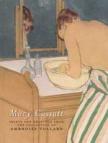A Daring and Innovative Artist
Mary Cassatt built and enjoyed an international reputation during her lifetime, and since her death in 1926, the popularity of her work has grown. Cassatt had studied painting from the age of 16 and worked for two decades solely as a painter. She took up printmaking when Edgar Degas invited her and Camille Pissaro to launch with him a new graphic arts journal to be called Le Jour et la Nuit. The trio produced a number of prints for the venture, but it never took off. Cassatt’s love of printmaking, however, did. She excelled at the art form and experimented boldly with it, taking a single image through multiple variations of form, tone, texture and color. After 1880 she produced as many original prints as she did paintings.
While Mary Cassatt, a 2008 exhibition catalogue from Adelson Galleries in New York City, is not written for the general reader, anyone can enjoy the images it contains. Over the last eight years Adelson Galleries has mounted three exhibitions (each with its own catalogue) devoted exclusively to Ambroise Vollard’s collection of Cassatt’s works on paper: her pencil sketches and drawings, prints (drypoint, etchings and aquatints) and counterproofs, which are prints made from pastels. Vollard, the legendary dealer who championed édouard Manet, Paul Cézanne and many of the Impressionists, as well as Pablo Picasso, bought Cassatt’s prints directly from her in bulk. Cassatt had pulled some of these from Degas’s printing press and later from her own. In the deal she sold Vollard prints at various stages of execution and with wide variations among them. Vollard also purchased a few Cassatt prints from dealers and other artists. He accumulated nearly 300 in all.
A few of the images in this catalogue will be familiar. Some of her prints had been bought or published in books, and many had been exhibited in retrospectives during Cassatt’s lifetime. But Vollard’s collection was largely kept intact after Cassatt’s death. More important, after Vollard’s death in 1939, his entire collection was bought by Henri M. Petiet, who kept these prints stored and unframed until he died in 1980. The Cassatt works in the three Adelson exhibits had therefore been unseen by the public for at least 60 years.
The catalogue contains a foreword by Warren Adelson and an essay by Nancy Mowll Mathews on the relationship of Cassatt and Vollard as artist and dealer/collector. Matthews has written an insightful biography of Cassatt and is an expert on her prints. The volume includes two short essays on Henri Petiet and on the papers used for printmaking, plus notes, some technical, on each print.
Cassatt’s works on paper stay true to her typical themes: women and children in natural poses, family and guests at home, and theater- and operagoers out on the town. For those like myself who appreciate the process of ideas taking shape, the sketches and drawings and stages that lead up to a painting more than the final work itself, this book is a special delight. One can see the artist’s mind at work, trying this and that, adding shadows, background or some detail, a pattern on a sleeve, or altering the entire mood by darkening the halftones, choosing a new color scheme or reversing the lights and darks. One can assess Cassatt’s decisions about medium, paper and size, in relation to the subject or desired effect. Some of the tenderest scenes—like “Quietude” and “The Caress,” both of which depict a woman holding a baby on her lap—are made in drypoint, a delicate medium in which an image is drawn directly onto a copper plate with a wire-thin needle. These images tend to be small, monochrome and minimalist, which ironically magnifies the emotional intimacy they convey. Other prints, often of multiple figures, are large. For these, like “Gathering Fruit,” Cassatt used several techniques, multiple plates, a full sheet of paper and luscious colors.
Glossy reproductions of Cassatt’s art—her prints, oils and drawings—are easy enough to find in book form. But a catalogue like this one, not just of Cassatt’s prints but of an array of prints purchased by a single dealer at a particular point in history, satisfies a reader who wants something beyond the general. Here one can see the artist in action, the dealer in action, and the two of them transacting business in their day. One also sees how works of art are moved across generations, each generation assessing whether this work of art (and this artist) still merits attention.
This article also appeared in print, under the headline “A Daring and Innovative Artist,” in the October 27, 2008, issue.








